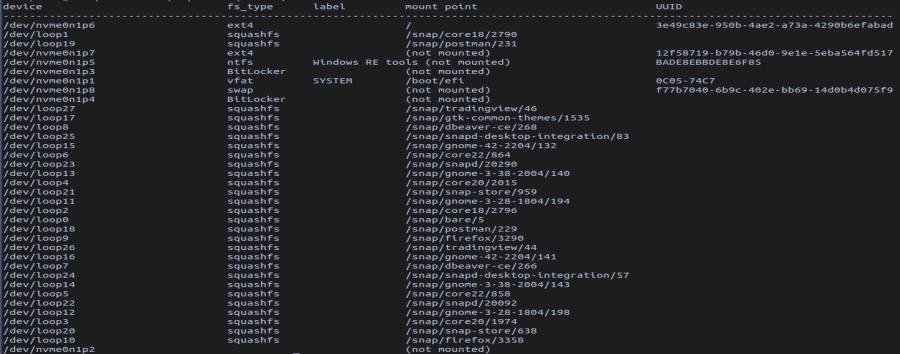blkid Command Examples in Linux
Last Updated :
13 Dec, 2023
blkid is a command to locate or print block device attributes. A block device can be a hard drive, solid-state drive (SSD), or removable storage device, such as a USB drive. It can determine the type of content (e.g., filesystem or swap) that a block device holds, and also the attributes (tokens, NAME=value pairs) from the content metadata (e.g., LABEL or UUID fields). The blkid command is part of the util-linux package. You need a Linux terminal to use this command.
Syntax of `blkid` Command in Linux
blkid [OPTIONS] [DEVICE_NAME]
Here,
OPTIONS – various command options to modify the behaviour of the blkid command.
DEVICE NAME – name of the device to be searched. This can be omitted.
Options available in `blkid` Command in Linux
Here is a list of some common options for the blkid command:
|
-d
|
–no-encoding
|
Don’t encode non-printing characters.
|
|
-g
|
–garbage-collect
|
Remove devices that no longer exist.
|
|
-h
|
–help
|
Display a usage message and exit.
|
|
-k
|
–list-filesystems
|
List all known filesystems and RAIDs and exit.
|
|
-o
|
–output FORMAT
|
Use the specified output format. FORMAT can be:
- full – print all tags
- value – print value of the tags
- list – print devices in a user-friendly format
- device – print device name only
and so on.
|
|
-t
|
–match-token NAME=VALUE
|
Search for block devices having attributes named NAME and value as VALUE. NAME can be TYPE, LABEL or UUID.
|
|
-U
|
–uuid [UUID]
|
Look up the device that uses this filesystem UUID.
|
For more options and details for the command check out the manual for the blkid command:
man blkid
Examples of blkid command in Linux
blkid has two main forms of operation: either searching for a device with a specific NAME=value pair, or displaying NAME=value pairs for one or more specified devices.
Display information of all block devices on your system using blkid command.
To display a list of all the block devices in your system enter the following command in the terminal.
blkid
If all block devices are not listed try re-executing the command in sudo mode.
sudo blkid
You will see a list of names of all block devices along with their information printed in the terminal.

list of all block devices with their types
Display information of a single block device using blkid command.
To display information about a single block device add its name after the command.
blkid /dev/nvme0n1p1
This commands prints the attributes of the block device mentioned. (Note: The name of the block device you entered should be present on your system.)

attributes of a single block device
Formatting command output using blkid command.
blkid command comes with multiple options to alter the behaviour of the command ouput. You can use the -o option along with some predefined value to modify the output of the command.
Print list of all block device names on your system
blkid -o device

list of block devices names
Print all devices with their attributes in a tabular format.
blkid -o list

Print a list of file available file system type using blkid command.
Enter the following command to print all the available filesystem types on your system.
blkid -k

list of all file_system types
Search devices with matching attribute names using blkid command.
You can also search for block device by matching attributes such as TYPE, LABEL or UUID using the -t (–match-token) option.
Find all block devices of TYPE ext4 using the following command:
blkid -t TYPE=ext4

list of block devices of type ext4
Print the list of block devices having LABEL value as SYSTEM
blkid -t LABEL=SYSTEM

list of block devices having label SYSTEM
Print block device having UUID value BADE8EBBDE8E6F85. Since UUID is unique only one block device will be listed in the output.
blkid -t UUID=BADE8EBBDE8E6F85

block device with UUID value BADE8EBBDE8E6F85
Conclusion
In this article we discussed the blkid command in Linux which is a crucial tool for identifying and displaying attributes of block devices, including hard drives and USBs. With options like listing filesystems, formatting output, and searching devices based on attributes, blkid provides a versatile solution for users managing storage devices from the Linux terminal. Its flexibility and functionality make it an essential resource for efficiently obtaining information about block devices on a system.
Share your thoughts in the comments
Please Login to comment...